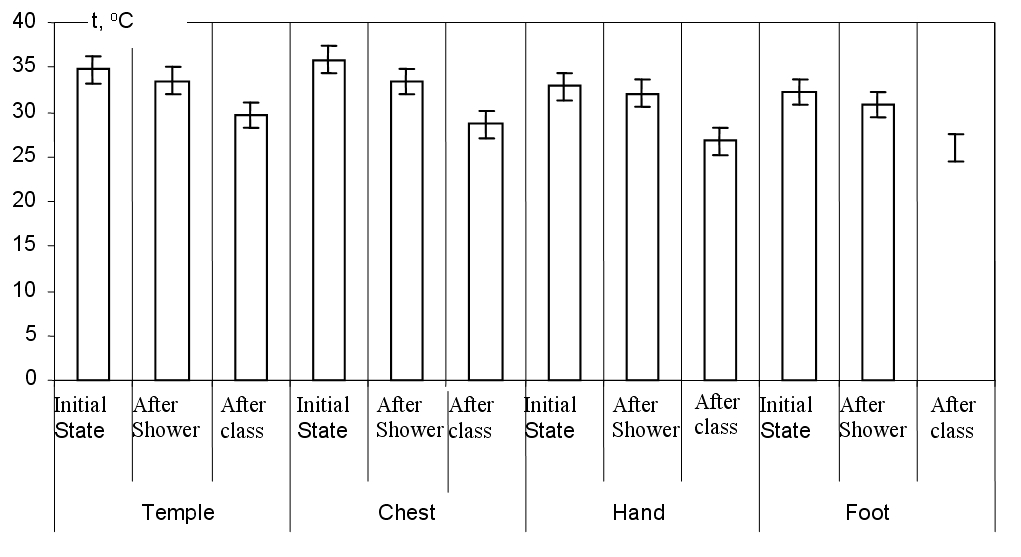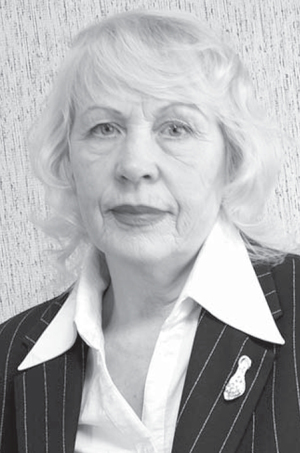THERMOREGULATION IN PREGNANT WOMEN WITHIN THERAPEUTIC SWIMMING CLASSES
Фотографии:
ˑ:
L.I. Aikina, associate professor, Ph.D.
Siberian state university of physical culture and sport, Omsk
Key words: pregnant women, therapeutic swimming, thermoregulation.
Motor activity has always been very important. Enhancement of the female reproductive health is impossible without motor activity. Physical exercises facilitate activation of metabolic processes and aquatic exercises provoke special adaptive responses [2], which are stronger than from overland exercises [3].
Hydrotherapy has been a top physical therapy by its ancient origin and health utility recognized by all nations at all times. Water has always been a symbol of cleanliness and purification.
According to Hippocrates, water cools the body, affects it chemically and mechanically, stimulates and provokes reaction. Greek physician Asclepiades considered water, diet and movements to be the main remedies and treated cold water as the best medicine along with rubbing and gymnastics.
However, the dark ages with its misunderstood religious depreciation of the human body, its health and beauty resulted in the neglected natural water therapies in favor of chemical medical substances [4].
Water exercises stipulate for specific adaptive responses. When put under water the cutaneous analyzer, highly sensitive to mechanical and thermal effects, links the body and the environment. Body temperature is one of the integrative indicators of the systemic condition. In chronophysiology it is called "the golden standard", which defines body status in a simple and objective way [6].
Cold applied to feet (by putting feet into the ice-cold water for 1 minute) was proved to provoke rising of skin temperature on the chest and back, increased oxygen consumption rates, pulmonary ventilation and respiratory coefficient [5].
Water exercises have a normalizing effect on the central nervous system, vegetative nervous system, improve cardiorespiratory system, cellular and humoral immunity [2].
Hormones and neuromediators in the blood plasma were studied by the authors [3] in pregnant women engaged in treatment, including physical exercises and conditioning using the natural factor (cold water). Proceeding from the authors' studies, treatment used during pregnancy stipulated for positive changes in the dynamics of neurohormonal factors. The levels of stress hormones and neuromediators went down, while the lactogenic hormones increased. Thus, the treatment normalized the hormonal status and facilitated prevention of endocrine disorders in pregnant women, which contributed to a normal course of pregnancy and prevented hormone disruption in both mother and her future child.
Cold conditioning is good for a woman, since a substantial part of the body is naked during delivery, and women not conditioned to the cold may feel cold or shivery with a vibrant musculocutaneous response.
The purpose of the present study was to consider the applicability of swimming as a recreational method for pregnant women.
The goal of the study was to analyze the effect of temperatures before and after therapeutic swimming classes in women in the antepartum period.
Materials and methods. The methods applied were as follows: literature analysis, questionnaire, observation, thermometry and mathematical and statistical methods.
54 women in the second and third trimesters of the physiological course of pregnancy were involved in the experiment. Temperature was measured in the following body areas: temple, chest (sternum area), hand (opisthenar), foot (dorsum). The measurements were taken with an infrared thermometer (WF-2000) before training classes (initial state), after taking a shower and after a therapeutic swimming class in the "Albatross" swimming pool of Siberian state university of physical culture (SibSUPC). The measurements totaled to 648 with the pool water temperature 27oC.
Results and discussion. Proceeding from the results of the study, in the initial state the temple, chest, hand and foot temperatures were 34.7±1.6oC, 35.8±1.4oC, 32.8±1.9oC and 32.2±1.8oC respectively.
After taking a shower the temperature in these body areas went down to 33.5±2.0oC (Р<0.05), 33.4±1.8oC (Р<0.05), 32.1±1.7oC (Р<0.05) and 30.8±1.8 oC (Р<0.05) in the temple, chest, hand and foot respectively.
More significant decrease in body temperature is observed after a 60 minute therapeutic swimming class. The class included 15% of pre-water exercises and 85% of water exercises. Water exercises involved:
- 30% - 2x25m front crawl leg action (board in hands), 2x25 m back crawl, 2x25 m sidestroke (left, right) and 2x25 m breaststroke with each series followed by breathing exercises (3-5-10 exhales);
- 40% - coordinated swimming strokes: 4x25 m sidestroke (right, left) 2x50 m breaststroke front and back, 2x50 front and back crawl;
- 15% - hip joint flexibility exercises, long diving exercises (2x5m), deep diving exercises (feet first 2x2m) and relaxation exercises. The exercises were repetitive and the rest period between exercises was voluntary. The heart rate when swimming ranged from 120 to 130 bpm at the total swimming distance 500 m.
Water exercises were followed by temperature measurements in various body areas. The data obtained were as follows: the temperature decrease amounted to 29.6±2.1, 28,6±1,5 (Р<0,05), 26,7±1,3 (Р<0,05) and 26,05±1,5 ºС (Р<0,05) for temple, chest, hand and foot accordingly. The body temperature after a shower and after a swimming class (Fig.) has changed significantly in all cases.
According to the observations and analysis of the data obtained, great reduction is marked in the chest temperature (to 7.2ºС) after a therapeutic swimming class, compared to the initial state. In the hand and foot areas the temperature difference between the initial state and after swimming amounts to 6.1ºС, while in the temple the variance is less significant and equal to 5.1ºС (Fig.).

Fig. Temperature in various body areas of pregnant women (before class, after shower, after therapeutic swimming)
None of the pregnant women caught cold after training classes, due to their bodies being gradually conditioned to the temperature rate.
Conclusion. The scientific and methodological literature analysis and the results of personal studies indicate to the high value of therapeutic swimming classes as a factor of body conditioning to the cold and, consequently, intensification of the body’s immunobiological mechanisms of pregnant women, stipulating for positive shifts in women's health and favourable labor.
Pregnant women's body temperature tends to decrease after a shower and drop significantly after 60-minute classes of therapeutic swimming.
According to the questionnaire of the training pregnant women, 30% felt uncomfortable when going into the water, but the discomfort was over in 2-3 minutes in the water.
100% of pregnant women felt comfortable after classes of therapeutic swimming and felt good after classes.
The change in women's thermoregulation to declining temperature of various body parts (from 5,1 to 7,2 º) is good for training the thermoregulation apparatus and is a body’s conditioning process resulting from regular classes of therapeutic swimming.
References
- Abramchenko, V.V. Remedial gymnastics in tocogynecology / V.V. Abramchenko, V.M. Bolotskikh. – St.Petersburg: ElBI-SPb, 2007, – 220 P. (In Russian)
- Akimov, E.B. Human temperature portrait and its correlation with aerobics, production and blood lactate level / E.B. Akimov et al. // Fiziologiya cheloveka. – 2010. – V. 36. – № 4. – P. 89–101. (In Russian)
- Bykov, A.T. Hydrotherapy: the role of submersion and physical exercises in it / A.T. Bykov et al. // Fizkultura v profilaktike, lechenii i reabilitatsii. – 2009. – № 1. (28). – P. 30–42. (In Russian)
- Sletov, N.V. Water treatment. Theory and practice of water treatment at home, in clinic and on resorts / N.V.Sletov. – Rostov-on-Don: Fenix, 2006. – P. 311. (In Russian)
- Smirnova, A.G. Neurohormonal mechanisms of effect of recreational procedures on pregnant women's body / A.G. Smirnova et al. // Fiziologiya cheloveka, – 2008. – V. 34 – № 3. – P. 133–136. (In Russian)
- Reinberg A. Chronobiologie et morbidite // Ann. Med. Interme. 1980. – V. 131. – № 4. – P. 517.
Author’s contacts: va55@yandex.ru


